View in other NatureServe Network Field Guides
NatureServe
Montana
Utah
Wyoming
Idaho
Wisconsin
British Columbia
South Carolina
Yukon
California
New York
Queen Alexandra's Sulphur - Colias alexandra
General Description
[From Ferris and Brown 1981; Scott 1986; Opler and Wright 1999; Glassberg 2001; Pyle 2002] Forewing 2.3-3.5 cm. Wing fringes yellow or greenish white. Upersurface clear yellow in males and most females (pale greenish white in some females), black border narrow in males, reduced or absent in females; forewing cell spot small and oval or round in males, variable in females; cell spot on hindwing small and variable, pale yellow to bright orange. Undersurface of hindwing soft green to yellowish-gray with central white discal spot often rimless or with weak pink rim, never with a small satellite spot.
Phenology
One flight, late June to early August in most places, mid-April to mid-May in Nevada; two flights, late May to mid-August in North Dakota, Nebraska, and Colorado plains (Scott 1986). May to August (Glassberg 2001). Late June to late August in the Rocky Mountain states (Ferris and Brown 1981), mid-May to mid-August in Colorado (Scott and Scott 1978; Scott and Epstein 1987), late April to early September in Oregon and Washington (Pyle 2002), mid-April to mid-September in Oregon (Warren 2005), June to August in British Columbia (Guppy and Shepard 2001).
Diagnostic Characteristics
Best determined by combination of the wing fringes yellow or greenish white; hindwing undersurface unmarked soft green, the central white discal spot often rimless or with weak pink rim, never with a small satellite spot.
Species Range
Montana Range
Range Descriptions

 Native
Native
Range Comments
Central British Columbia east to southern Saskatchewan, south through intermountain west to eastern California, central Arizona, and New Mexico (Scott 1986; Opler and Wright 1999; Glassberg 2001; Guppy and Shepard 2001); 1829 m to 3231 m elevation in Colorado (Brown 1957; Scott and Scott 1978; Ferris 1993), 122 m to at least 2835 m elevation in Oregon (Warren 2005). In Montana, reported from at least 32 counties across the state (Kohler 1980; Ferris 1993; Stanford and Opler 1993; FLMNH Lepidopterists' Society database), to at least 1753 m elevation. Uncommon to common (Glassberg 2001).
Observations in Montana Natural Heritage Program Database
Number of Observations: 25
(Click on the following maps and charts to see full sized version)
Map Help and Descriptions
Relative Density
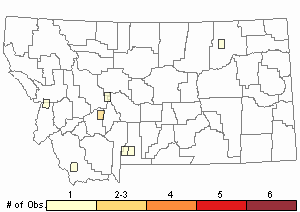
Recency
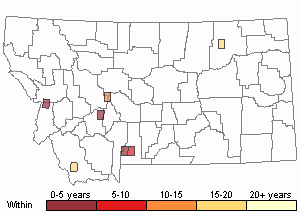
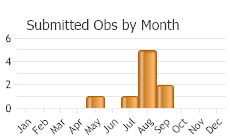
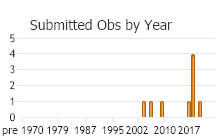
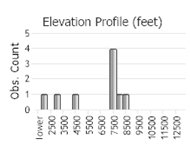 (Observations spanning multiple months or years are excluded from time charts)
(Observations spanning multiple months or years are excluded from time charts)
Migration
Non-migratory. Adults may move up to 8 km, but usually about 0.6 km during a lifetime (Scott 1986).
Habitat
Open areas, road edges, fields, sagebrush flats, prairie, foothill grassland, montane meadows in aspen or pine (Emmel 1964; Ferris 1972, 1993; Scott 1986; Opler and Wright 1999; Glassberg 2001). Habitat in Montana not described but probably similar. In Greater Yellowstone Ecosystem reported from meadows, fields, brush land, roadsides, clearings, forest edges, sagebrush (Debinski and Pritchard 2002).
Food Habits
Larval food plants include native and exotic members of the pea family, such as Astragalus (several species), Hedysarum, Lathyrus, Lupinus, Medicago, Oxytropis, Thermopsis (several species), Trifolium, and Vicea (Ferris 1972, 1993; Ferris and Brown 1981; Scott 1986, 1992, 2006; Pyle 2002; Graves and Shapiro 2003; Warren 2005). Adults feed on flower nectar (including Apocynum, Astragalus, Carduus, Ceanothus, Cirsium, Delphinium, Erigeron, Eriogonum, Erysimum, Gaillardia, Geranium, Heterotheca, Lupinus, Medicago, Oxytropis, Rudbeckia, Sedum, Sisymbrium, Solidago, Trifolium) and mud (Emmel 1964; Scott 2014).
Reproductive Characteristics
Females lay eggs singly on host plant leaves, mostly the upper surface (Hayes 1980; Scott 1986, 1992, 2006; Guppy and Shepard 2001). Number of eggs per ovariole (1/8 total supply) about 200 (Ehrlich and Ehrlich 1978), but may lay 600 of these (Guppy and Shepard 2001). Eggs hatch in 4-11 days (depending on temperature), reach L2 or L3 instar and overwinter (diapause) in about 26-28 days post egg-hatch, after exiting diapause reach L5 instar and pupate in about 12-13 days, adults eclose (exit pupae) in about 11-15 days (Hayes 1980; Guppy and Shepard 2001; James and Nunnallee 2011); depending on temperature, may develop more quickly in captivity (Ae 1958). Larvae solitary, eat host plant leaves, rest on upper leaf surface midribs, build no nest, diapause as L2 or l3 instars (sometimes L4 instar), overwinter and pupate at base of host plant in litter (Hayes 1980; Scott 1986; Ferris 1993; Guppy and Shepard 2001; James and Nunnallee 2011). Males patrol throughout the day over all kinds of open terrain in search of females (Scott 1975b, 1986). Males may live a month but usually about 6-12 days, females less (Scott 1986).
Stewardship Responsibility
References
- Literature Cited AboveLegend:
 View Online Publication
View Online Publication Ae, S.A. 1958. Comparative studies of developmental rates, hibernation, and food plants in North American Colias (Lepidoptera, Pieridae). American Midland Naturalist 60: 84-96.
Ae, S.A. 1958. Comparative studies of developmental rates, hibernation, and food plants in North American Colias (Lepidoptera, Pieridae). American Midland Naturalist 60: 84-96. Brown, F.M. 1957. Colorado Butterflies. Proceedings; Numbers Three through Seven. Denver Museum of Natural History, Denver, Co.
Brown, F.M. 1957. Colorado Butterflies. Proceedings; Numbers Three through Seven. Denver Museum of Natural History, Denver, Co. Debinski, D.M. and J.A. Pritchard. 2002. A field guide to the butterflies of the Greater Yellowstone Ecosystem. Lanham, MD: Roberts Rinehart Publishers. 107 p.
Debinski, D.M. and J.A. Pritchard. 2002. A field guide to the butterflies of the Greater Yellowstone Ecosystem. Lanham, MD: Roberts Rinehart Publishers. 107 p. Ehrlich, A.H. and P.R. Ehrlich. 1978. Reproductive strategies in the butterflies: I. Mating frequency, plugging, and egg number. Journal of the Kansas Entomological Society 51(4): 666-697.
Ehrlich, A.H. and P.R. Ehrlich. 1978. Reproductive strategies in the butterflies: I. Mating frequency, plugging, and egg number. Journal of the Kansas Entomological Society 51(4): 666-697. Emmel, T.C. 1964. The ecology and distribution of butterflies in a montane community near Florissant, Colorado. American Midland Naturalist 72(2): 358-373.
Emmel, T.C. 1964. The ecology and distribution of butterflies in a montane community near Florissant, Colorado. American Midland Naturalist 72(2): 358-373. Ferris, C.D. 1972. Notes on certain species of Colias (Lepidoptera: Pieridae) found in Wyoming and associated regions. Bulletin of the Allyn Museum 5:1-23.
Ferris, C.D. 1972. Notes on certain species of Colias (Lepidoptera: Pieridae) found in Wyoming and associated regions. Bulletin of the Allyn Museum 5:1-23. Ferris, C.D. 1993. Reassessment of the Colias Alexandra Group, the Legume-Feeding Species, and Preliminary Cladistic Analysis of the North American Colias (Pieridae: Coliadinae). Bulletin of the Allyn Museum 138: 1-91.28.
Ferris, C.D. 1993. Reassessment of the Colias Alexandra Group, the Legume-Feeding Species, and Preliminary Cladistic Analysis of the North American Colias (Pieridae: Coliadinae). Bulletin of the Allyn Museum 138: 1-91.28. Ferris, C.D. and F.M. Brown (eds). 1981. Butterflies of the Rocky Mountains. Univ. of Oklahoma Press. Norman. 442 pp.
Ferris, C.D. and F.M. Brown (eds). 1981. Butterflies of the Rocky Mountains. Univ. of Oklahoma Press. Norman. 442 pp. Glassberg, J. 2001. Butterflies through Binoculars: A Field Guide to the Butterflies of Western North America. Oxford University Press.
Glassberg, J. 2001. Butterflies through Binoculars: A Field Guide to the Butterflies of Western North America. Oxford University Press. Graves, S.D. and A.M. Shapiro. 2003.Exotics as host plants of the California butterfly fauna. Biological Conservation 110: 413-433.
Graves, S.D. and A.M. Shapiro. 2003.Exotics as host plants of the California butterfly fauna. Biological Conservation 110: 413-433. Guppy, C.S. and J.H. Shepard. 2001. Butterflies of British Columbia: including western Alberta, southern Yukon, the Alaska Panhandle, Washington, northern Oregon, northern Idaho, northwestern Montana. UBC Press (Vancouver, BC) and Royal British Columbia Museum (Victoria, BC). 414 pp.
Guppy, C.S. and J.H. Shepard. 2001. Butterflies of British Columbia: including western Alberta, southern Yukon, the Alaska Panhandle, Washington, northern Oregon, northern Idaho, northwestern Montana. UBC Press (Vancouver, BC) and Royal British Columbia Museum (Victoria, BC). 414 pp. Hayes, J.L. 1980. Some aspects of the biology of the developmental stages of Colias alexandra (Pieridae). Journal of the Lepidopterists' Society. 34: 345-352.
Hayes, J.L. 1980. Some aspects of the biology of the developmental stages of Colias alexandra (Pieridae). Journal of the Lepidopterists' Society. 34: 345-352. James, D.G. and D. Nunnallee. 2011. Life histories of Cascadia butterflies. Corvallis, OR: Oregon State University Press. 447 p.
James, D.G. and D. Nunnallee. 2011. Life histories of Cascadia butterflies. Corvallis, OR: Oregon State University Press. 447 p. Kohler, S. 1980. Checklist of Montana Butterflies (Rhopalocera). Journal of the Lepidopterists' Society 34(1): 1-19.
Kohler, S. 1980. Checklist of Montana Butterflies (Rhopalocera). Journal of the Lepidopterists' Society 34(1): 1-19. Opler, P.A. and A.B. Wright. 1999. A field guide to western butterflies. Second edition. Peterson Field Guides. Houghton Mifflin Company, Boston, Massachusetts. 540 pp.
Opler, P.A. and A.B. Wright. 1999. A field guide to western butterflies. Second edition. Peterson Field Guides. Houghton Mifflin Company, Boston, Massachusetts. 540 pp. Pyle, R.M. 2002. The butterflies of Cascadia: a field guide to all the species of Washington, Oregon, and surrounding territories. Seattle Audubon Society, Seattle, Washington. 420 pp.
Pyle, R.M. 2002. The butterflies of Cascadia: a field guide to all the species of Washington, Oregon, and surrounding territories. Seattle Audubon Society, Seattle, Washington. 420 pp. Scott, J.A. 1975b. Mate-locating behavior of western North American butterflies. Journal of Research on the Lepidoptera 14:1-40.
Scott, J.A. 1975b. Mate-locating behavior of western North American butterflies. Journal of Research on the Lepidoptera 14:1-40. Scott, J.A. 1986. The butterflies of North America: a natural history and field guide. Stanford University Press, Stanford, California.
Scott, J.A. 1986. The butterflies of North America: a natural history and field guide. Stanford University Press, Stanford, California. Scott, J.A. 1992. Hostplant records for butterflies and skippers (mostly from Colorado) 1959-1992, with new life histories and notes on oviposition, immatures, and ecology. Papilio new series #6. 185 p.
Scott, J.A. 1992. Hostplant records for butterflies and skippers (mostly from Colorado) 1959-1992, with new life histories and notes on oviposition, immatures, and ecology. Papilio new series #6. 185 p. Scott, J.A. 2006. Butterfly hostplant records, 1992-2005, with a treatise on the evolution of Erynnis, and a note on new terminology for mate-locating behavior. Papilio new series #14. 74 p.
Scott, J.A. 2006. Butterfly hostplant records, 1992-2005, with a treatise on the evolution of Erynnis, and a note on new terminology for mate-locating behavior. Papilio new series #14. 74 p. Scott, J.A. 2014. Lepidoptera of North America 13. Flower visitation by Colorado butterflies (40,615 records) with a review of the literature on pollination of Colorado plants and butterfly attraction (Lepidoptera: Hersperioidea and Papilionoidea). Contributions of the C.P. Gillette Museum of Arthopod Diversity. Fort Collins, CO: Colorado State University. 190 p.
Scott, J.A. 2014. Lepidoptera of North America 13. Flower visitation by Colorado butterflies (40,615 records) with a review of the literature on pollination of Colorado plants and butterfly attraction (Lepidoptera: Hersperioidea and Papilionoidea). Contributions of the C.P. Gillette Museum of Arthopod Diversity. Fort Collins, CO: Colorado State University. 190 p. Scott, J.A. and G.R. Scott. 1978. Ecology and distribution of the butterflies of southern central Colorado. Journal of Research on the Lepidoptera 17(2): 73-128.
Scott, J.A. and G.R. Scott. 1978. Ecology and distribution of the butterflies of southern central Colorado. Journal of Research on the Lepidoptera 17(2): 73-128. Scott, J.A. and M.E. Epstein. 1987. Factors affecting phenology in a temperate insect community. American Midland Naturalist 117(1): 103-118.
Scott, J.A. and M.E. Epstein. 1987. Factors affecting phenology in a temperate insect community. American Midland Naturalist 117(1): 103-118. Stanford, R.E. and P.A. Opler. 1993. Atlas of western USA butterflies: including adjacent parts of Canada and Mexico. Unpubl. Report. Denver and Fort Collins, Colorado 275 pp.
Stanford, R.E. and P.A. Opler. 1993. Atlas of western USA butterflies: including adjacent parts of Canada and Mexico. Unpubl. Report. Denver and Fort Collins, Colorado 275 pp. Warren, A.D. 2005. Lepidoptera of North America 6: Butterflies of Oregon, their taxonomy, distribution, and biology. Contributions of the C. P. Gillette Museum of Arthropod Diversity, Colorado State University. Fort Collins, Colorado. 406 pp.
Warren, A.D. 2005. Lepidoptera of North America 6: Butterflies of Oregon, their taxonomy, distribution, and biology. Contributions of the C. P. Gillette Museum of Arthropod Diversity, Colorado State University. Fort Collins, Colorado. 406 pp.
- Additional ReferencesLegend:
 View Online Publication
View Online Publication
Do you know of a citation we're missing? Allen, T.J., J.P. Brock, and J. Glassberg. 2005. Caterpillars in the field and garden: a field guide to the butterfly caterpillars of North America. Oxford University Press.
Allen, T.J., J.P. Brock, and J. Glassberg. 2005. Caterpillars in the field and garden: a field guide to the butterfly caterpillars of North America. Oxford University Press. Brock, J.P. and K. Kaufman. 2003. Kaufman Field Guide to Butterflies of North America. Houghton Mifflin Company, New York, NY 284 pp.
Brock, J.P. and K. Kaufman. 2003. Kaufman Field Guide to Butterflies of North America. Houghton Mifflin Company, New York, NY 284 pp. Caruthers, J.C., and D. Debinski. 2006. Montane meadow butterfly species distributions in the Greater Yellowstone Ecosystem. University of Wyoming National Park Service Research Center Annual Report, 2006. Vol. 30, Art. 14. 85-96.
Caruthers, J.C., and D. Debinski. 2006. Montane meadow butterfly species distributions in the Greater Yellowstone Ecosystem. University of Wyoming National Park Service Research Center Annual Report, 2006. Vol. 30, Art. 14. 85-96. Debinski, D. M. 1991. Inventory and monitoring of biodiversity: an assessment of methods and a case study of Glacier National Park, MT. Ph.D. Dissertation. Montana State University, Bozeman. 205 p.
Debinski, D. M. 1991. Inventory and monitoring of biodiversity: an assessment of methods and a case study of Glacier National Park, MT. Ph.D. Dissertation. Montana State University, Bozeman. 205 p. Layberry, R.A., P.W. Hall, and J.D. LaFontaine. 1998. The Butterflies of Canada. University of Toronto Press. 280 pp. + color plates.
Layberry, R.A., P.W. Hall, and J.D. LaFontaine. 1998. The Butterflies of Canada. University of Toronto Press. 280 pp. + color plates. Opler, P.A., K. Lotts, and T. Naberhaus, coordinators. 2010. Butterflies and moths of North America. Big Sky Institute, Bozeman, MT. Available at: www.butterfliesandmoths.org (Accessed 15 June 2015).
Opler, P.A., K. Lotts, and T. Naberhaus, coordinators. 2010. Butterflies and moths of North America. Big Sky Institute, Bozeman, MT. Available at: www.butterfliesandmoths.org (Accessed 15 June 2015).
- Web Search Engines for Articles on "Queen Alexandra's Sulphur"
- Additional Sources of Information Related to "Insects"





